FED, Liquidity and Rain
Posted On Wednesday, Jul 26, 2023
“In the world of investing, perception often swings from flawless to hopeless”
This quote by Howard Marks, aptly portrays the changes in market narratives over the last few months. In the US, the bond market narrative has been toggling between two extremes - “persistent high inflation” and “recession”.
This has put the bond markets around the world on an emotional roller coaster. A month back, the US treasury futures were pricing for two or more rate cuts. Now, the expectation has shifted to two more rate hikes in 2023.
This has not just pushed US treasury yields higher; but moved the sentiments in the Indian bond market too; sometimes in contrast to the local developments. The 10-year Indian government bond (Gsec) yield which had fallen to lows of 6.96% during early June, has jumped to the peak of 7.17% before falling back to the current levels of 7.07%.
Chart – I: Indian bond yields has been tracking long term US treasury yields
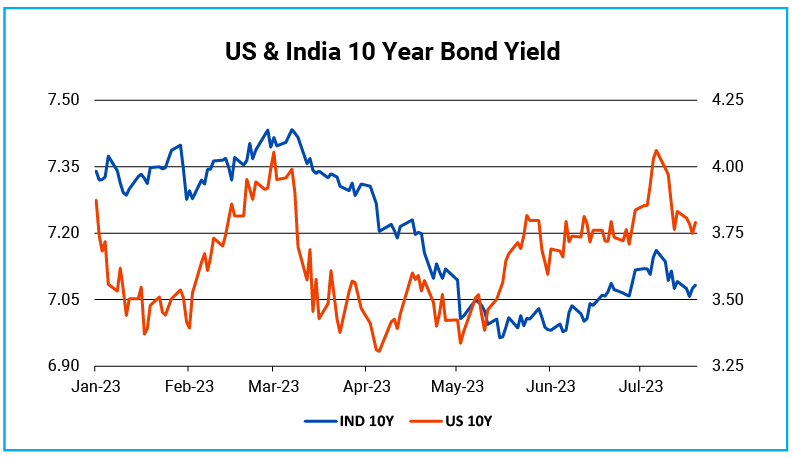
Source - Refinitiv, Quantum Research, Data as of Jul 20, 2023
Past Performance may or may not sustain in future
The US Fed is expected to hike the Fed Funds rate by 25 basis points in its upcoming review meeting on July 26th. This is already a part of market psyche. Thus, the rate hike by itself is unlikely to have any material impact on the markets. Instead, the bond market will closely follow the Fed’s language to find cues about the future course of monetary policy.
We foresee following possible outcomes:
| Fed Decision | Market Impact |
| Hike by 25 basis Points + Hawkish tone indicating more rate hikes to come | Short term treasury rate will move up. However, long term rates might not move much as the rate hiking cycle is near its end and tighter financial condition will increase the probability of recession in the US. Indian yields share stronger linkages with the longer-term treasury yields than shorter term USTs. Thus, this outcome is unlikely to cause any material impact on the Indian bond market, though yields might move up initially on the Fed’s hawkish stance. |
| Hike by 25 basis points +Neutral to Dovish tone indicating the rate hiking cycle is over | Short term US treasury rate move up marginally, while long term rates fall. Marginal decline in Indian Bond yields. |
| No Rate hike + Cautious Tone | This would indicate that the bar for rate hike is very high, and the rate hiking cycle is over for now. Sharper down move in the long-term US treasury. Indian bond yields will come down though at a moderate pace. |
Don’t miss the wood for the trees.
The broader picture is that the rate hiking cycle is near its end. One or two tactical rate hikes by the US Fed cannot be ruled out. But these are unlikely to have any lasting impact on the Indian bond markets.
At this juncture, we shall be focusing more on the domestic developments particularly around the inflation and liquidity.
Shifting Liquidity Dynamics
The less talked aspect of the RBI’s monetary policy normalization last year, was its covert tightening of liquidity condition. It reduced the durable liquidity surplus from ~Rs. 11 trillion in December 2021 to below ~Rs. 3 trillion by December 2022, and tightened further to below Rs. 1 trillion by April 2023.
Back in April, we expected the core liquidity (Banks’ excess liquidity with the RBI+ government balance) to turn into deficit from May 2023.
But it turned out differently in the last three months. The core liquidity increased to surplus of over Rs. 3.7 trillion as per the latest available data for July 14, 2023. This was mainly contributed by – (1) deposit of Rs. 2000 currency notes after the RBI’s announcement to withdraw it from circulation, and (2) Foreign Exchange (FX) purchases by the RBI.
Since the announcement of Rs. 2000 currency note withdrawal on May 19, 2023, the currency in circulation (CIC) has declined by Rs. 1.26 trillion (as per the latest available data on July 14, 2023). Typically, this used to be a calm period for the CIC with no major changes. Thus, almost entire drop in CIC (increase in banking system liquidity) can be attributed to the deposit of Rs. 2000 currency notes.
On the FX front, the RBI has been quite aggressive in rebuilding it reserves. It bought over USD 15 billion of foreign exchange during April and May 2023. The FX buying spree continued in June and in July so far. Our reverse calculation from changes in liquidity condition during June and July, indicates additional USD 6 billion FX purchases by the RBI. These FX purchases added around Rs. 1.7 trillion of durable liquidity into the banking system.
Chart- II: Liquidity condition eased due to Rs. 2000 note withdrawal & RBI’s FX buying
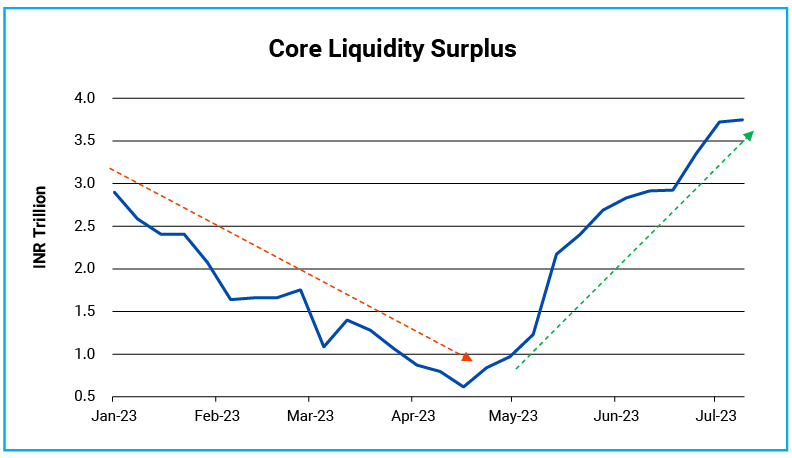
Source – RBI, Quantum Research, Data as of Jul 14, 2023
The broader view of dollar depreciation going forward and foreign investors rising interest in Indian financial markets, support continuation of FPI inflows into the India equity and debt markets. This would ease the liquidity condition even further.
From the bond markets’ perspective, the impact of liquidity is two-fold:
Easy liquidity condition brought down the short-term yields in the money markets. The yield on the 1-year treasury bill came down from 7.16% on March 31, 2023, to around 6.87% on July 20, 2023. During the same period, AAA PSU CDs witnessed around 23 bps drop in yields from 7.61% to 7.38%.
Given our view on liquidity, we expect money market rates to remain well anchored around the policy repo rate. This, in turn, might keep the front end of the yield curve steep.
Chart – III: Easy liquidity condition to keep short term rates anchored around the Repo Rate
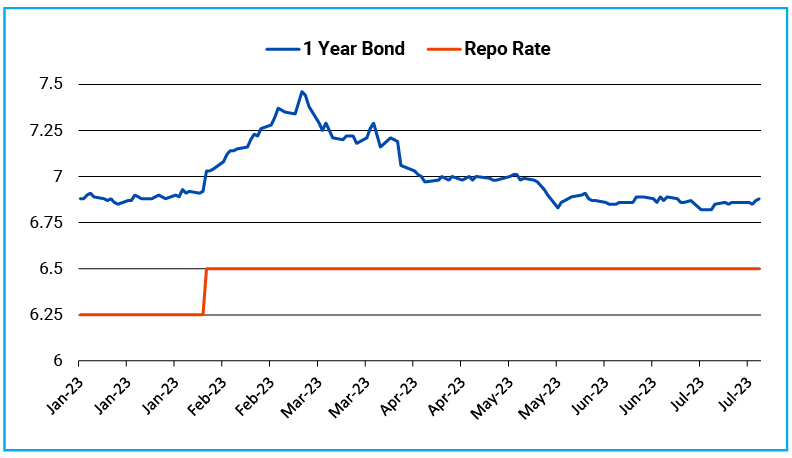
Source – Refinitiv, Quantum Research, Data as of Jul 20, 2023
Past Performance may or may not sustain in future
Increased bank deposits have boosted banks demand for bonds. However, on the other hand, it has negated the possibility of OMO purchases by the RBI as expected by many market participants earlier. On net basis, demand supply looks in balance for this year.
All in all, easy liquidity condition is likely to remain supportive for the bond market keeping a lid on the bond yields.
Cloudy Foodflation
Monsoon came to India with a delay of at least 8 days; but picked up quickly. As per the latest available data on July 20, 2023, overall rainfall since start of the monsoon season stands at 3% higher than the long period average (LPA).
However, the rainfall distribution has been uneven with downpour in Northwest region (45% high than LPA) and severe shortfall in East & Northeast (-21% lower than LPA) and South peninsula (-17% lower than LPA).
Chart – IV: Total Rainfall above Normal; but with uneven distribution
| Region | Actual | Normal | % Departure from Long Period Average |
| EAST AND NORTHEAST INDIA | 481.8 | 610.7 | -21% |
| NORTHWEST INDIA | 297.8 | 206 | 45% |
| CENTRAL INDIA | 404.1 | 369.5 | 9% |
| SOUTH PENNINSULA INDIA | 241.7 | 290 | -17% |
| COUNTRY AS WHOLE | 351.9 | 342.1 | 3% |
Source – IMD, Data as of Jul 20, 2023
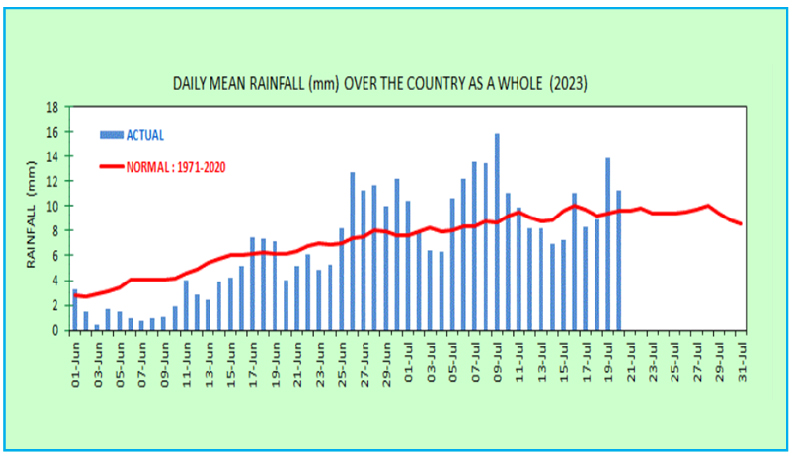
Source – IMD, Data as of Jul 20, 2023
Late arrival and patchy rain distribution delayed the sowing of Kharif crops which were lagging to the extent of -23% (compared to the area sown during corresponding period last year) for important crops like cereals and pulses until July 3, 2023.
Since then, the sowing activity picked up sharply along with the widening of monsoon coverage. As per the latest available data on July 14, 2023, total area sown is down only -1.6% YoY as against -5.4% a week back. We would expect further increase in the area sown for most of the important crops over the coming two weeks.
Chart – V: Kharif sowing started late but recovering fast
| Progress of Area Coverage under Kharif crops (% change over corresponding period last year) | ||
| Crops | 09-Jul-23 | 14-Jul-23 |
| Rice | -15.8% | -6.1% |
| Total Pulses | -17.9% | -13.3% |
| Total Coase Cereals | 19.7% | 18.1% |
| Total Oilseeds | -10.2% | 1.7% |
| Sugarcane | 4.7% | 4.7% |
| Total Jute and Mesta | -12.0% | -7.8% |
| Cotton | -5.2% | -11.7% |
| Total | -5.4% | -1.6% |
Source – Agricoop, Quantum Research, Data as of Jul 14, 2023
Notwithstanding the sowing recovery, food prices have started to move higher quickly. Sharp jump in vegetable prices led by tomatoes captured everyone’s attention recently. This caused an upside surprise of more than 20 basis points from the median market forecast in the CPI inflation in June.
CPI inflation will face further upward pressure during July – September quarter due to sharp jump in vegetable prices. However, it should correct in the Q3 and Q4 in line with the seasonal trend in vegetable prices.
More worrying trend though is the recent increase in prices of rice and pulses which can contribute significant upside to the inflation for a longer period. Any shortfall in the production of these crops will be a key risk for the inflation outlook.
We would be closely monitoring the developments around Kharif sowing and food prices over the coming weeks to affirm our inflation outlook.
We opine this risk is not adequately factored in the bond valuations. Thus, we would prefer to take a cautious stance and wait for these risks to subside or valuations to correct.
Bond Outlook
Looking through all the near-term noises, the medium-term outlook for bonds looks favourable supported by peaked policy rates, comfortable liquidity condition and strong external position.
Given the stretched valuations and near-term risk due to weak rainfall trend, we see a high possibility of long-term yields moving higher from current levels in near term. However, the upside on yields should be limited to 10-20 basis points given the overall macro backdrop is favourable.
Market condition for short term bonds have turned favorable with pause in rate hikes and prevailing easy liquidity condition.
At this stage, the 2-5 years maturity government bonds are attractively positioned with a medium-term outlook.
In line with our near-term cautious view, we maintain a lower portfolio duration in our actively managed bond fund as a tactical position. However, we shall look to extend the portfolio duration in every market dip.
What should Investors do?
With government bond yields above 7%, there is decent accrual available at current levels. Even in the real term (adjusted for inflation), government bonds are offering meaningful positive real yield. With expected CPI inflation of 5.1% (RBI’s FY24 inflation estimate) and a 1-year Gsec yield at 6.9%, the real yield is around 180 basis points.
Investors with 2-3 years holding period can consider Dynamic bond funds which have flexibility to change the portfolio positioning as per the evolving market conditions.
Investors with shorter investment horizons and low-risk appetites should stick with liquid funds.
Portfolio Positioning
Scheme Name | Strategy |
The scheme invests in debt securities of up to 91 days of maturity issued by the government and selected public sector companies. | |
The scheme to invest in debt securities issued by the government and selected public sector companies. The scheme follows an active duration management strategy and increases/decreases the portfolio duration (sensitivity to interest rates changes) in accordance with the Interest Rate Outlook. Given the near-term uncertainties around food inflation, we are maintaining lower portfolio duration than the benchmark in the scheme. However, we are ready to act quickly to market developments and upcoming data points. |
For any queries directly linked to the insights and data shared in the newsletter, please reach out to the author – Pankaj Pathak, Fund Manager – Fixed Income at [email protected].
For all other queries, please contact Neeraj Kotian – Area Manager, Quantum AMC at [email protected] / [email protected] or call him on Tel: 9833289034
Read our last few Debt Market Observer write-ups -
- The Last Lap
- Are Long Bonds Overvalued?
Portfolio Information Scheme Name: Quantum Liquid Fund | |
| Description (if any) | |
Annualised Portfolio YTM*: | 6.69% |
Macaulay Duration | 43 days |
Residual Maturity | 43 days |
As on (Date) | 31-05-2023 |
*in case of semi annual YTM, it will be annualised
Name of the Scheme | This product is suitable for investors who are seeking* | Riskometer |
Quantum Liquid Fund An Open-ended Liquid Scheme. A relatively low interest rate risk and relatively low credit risk. |
| 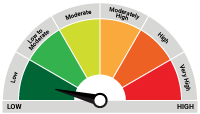 Investors understand that their principal will be at Low Risk |
Quantum Dynamic Bond Fund An Open-ended Dynamic Debt Scheme Investing Across Duration. A relatively high interest rate risk and relatively low credit risk. |
| 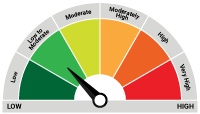 Investors understand that their principal will be at Low to Moderate Risk |
* Investors should consult their financial advisers if in doubt about whether the product is suitable for them.
| Potential Risk Class Matrix – Quantum Dynamic Bond Fund | |||
Credit Risk → | Relatively Low | Moderate (Class B) | Relatively High (Class C) |
Interest Rate Risk↓ | |||
Relatively Low (Class I) | |||
| Moderate (Class II) | |||
| Relatively High (Class III) | A-III | ||
| Potential Risk Class Matrix – Quantum Liquid Fund | |||
Credit Risk → | Relatively Low | Moderate (Class B) | Relatively High (Class C) |
Interest Rate Risk↓ | |||
| Relatively Low (Class I) | A-I | ||
| Moderate (Class II) | |||
| Relatively High (Class III) | |||
Disclaimer, Statutory Details & Risk Factors:The views expressed here in this article / video are for general information and reading purpose only and do not constitute any guidelines and recommendations on any course of action to be followed by the reader. Quantum AMC / Quantum Mutual Fund is not guaranteeing / offering / communicating any indicative yield on investments made in the scheme(s). The views are not meant to serve as a professional guide / investment advice / intended to be an offer or solicitation for the purchase or sale of any financial product or instrument or mutual fund units for the reader. The article has been prepared on the basis of publicly available information, internally developed data and other sources believed to be reliable. Whilst no action has been solicited based upon the information provided herein, due care has been taken to ensure that the facts are accurate and views given are fair and reasonable as on date. Readers of this article should rely on information/data arising out of their own investigations and advised to seek independent professional advice and arrive at an informed decision before making any investments. Mutual fund investments are subject to market risks read all scheme related documents carefully. |
Related Posts
-

The Pivot
Posted On Friday, Apr 21, 2023
The fiscal year 2022-23 has come to an end. The defining feature
Read More -

Yield Curve Inversion Ahead
Posted On Thursday, Mar 23, 2023
Indian money markets have tightened meaningfully over the last one and a half month.
Read More -

Past, Present, and Future of Inflation
Posted On Friday, Feb 24, 2023
Inflation has been one of the biggest challenges in the post-pandemic world.
Read More




